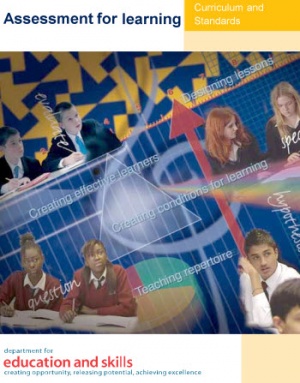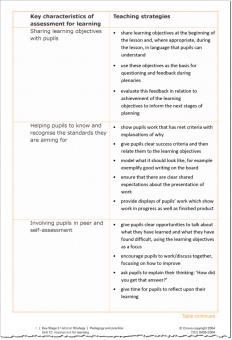Assessment for Learning: Difference between revisions
No edit summary |
mNo edit summary |
||
| Line 5: | Line 5: | ||
|resourcenumber=TE0082 | |resourcenumber=TE0082 | ||
|age= Secondary | |age= Secondary | ||
|content= The | |content=This study unit offers practical strategies that teachers can use to improve their understanding of assessment for learning. Assessment for learning is key because it is a powerful means to help tailor teaching to motivate and involve pupils to take their next step in learning. The techniques suggested are tried and tested; draw on academic research and teaching experience. The unit aims to build a teaching repertoire and reflect on practice. It includes case studies, research and suggestions to set personal targets for the future. | ||
|tagline=Research shows that good practice in assessment for learning can bring about significant gains in pupil attainment | |||
|image=Afl0.jpg | |||
|strategy= | |strategy= | ||
|Learning Objectives= By working through the document you should enhance your understanding of AfL, and develop some strategies for utilising assessment effectively in classroom contexts. | |Learning Objectives= By working through the document you should enhance your understanding of AfL, and develop some strategies for utilising assessment effectively in classroom contexts. | ||
| Line 15: | Line 17: | ||
|resources=[[file:AfL.doc]] | |resources=[[file:AfL.doc]] | ||
}} | }} | ||
[[File:Afl2.jpg|border|340x340px| |Open Government licence; Preview snapshot ]] | |||
{{DfE}} | |||
[[Category:Secondary]] [[Category:Teacher Education]][[Category:External Resource]] | [[Category:Secondary]] [[Category:Teacher Education]][[Category:External Resource]] | ||
Revision as of 21:58, 11 September 2012
About. This study unit offers practical strategies that teachers can use to improve their understanding of assessment for learning. Assessment for learning is key because it is a powerful means to help tailor teaching to motivate and involve pupils to take their next step in learning. The techniques suggested are tried and tested; draw on academic research and teaching experience. The unit aims to build a teaching repertoire and reflect on practice. It includes case studies, research and suggestions to set personal targets for the future.
Pedagogical content. Assessment for learning has been defined as the process of interpreting evidence to decide where learners are in their learning, where they need to go and how best to get there. When assessment(ta) for learning is well established in a classroom, pupils are actively involved in their learning; able to judge the success of their work and to take responsibility for their own progress.
For some shorter more focused documents drawn from this DfES document see Giving Oral Feedback, Giving Written Feedback, Sharing Learning Objectives and Outcomes. (edit)
| Resource details | |
| Title | Assessment for Learning |
| Topic | [[Topics/Assessment|Assessment]] |
| Teaching approach | [[Teaching Approaches/Assessment|Assessment]] |
| Learning Objectives | By working through the document you should enhance your understanding of AfL, and develop some strategies for utilising assessment effectively in classroom contexts. |
| Format / structure | .doc |
| Subject | [[Resources/Teacher Education|Teacher Education]] |
| Age of students / grade | [[Resources/Secondary|Secondary]], [[Resources/Higher|Higher]]
|
| Related ORBIT Wiki Resources | See other DfE(i) resources |
| Files and resources to view and download |
|
- This resource is part of the DfES resource "Pedagogy and practice: Teaching and learning in secondary schools" (ref: 0423-2004G) which can be downloaded from the National Archives http://webarchive.nationalarchives.gov.uk/20110809101133/nsonline.org.uk/node/97131 The whole resource (512 pages) can be downloaded as a pdf File:Pedagogy and Practice DfES.pdf
- The resource booklets, and many 'harvested' documents are available to download, generally in editable formats from the ORBIT resources http://orbit.educ.cam.ac.uk/wiki/Category:DfE
- The videos from the accompanying DVDs are available http://orbit.educ.cam.ac.uk/wiki/DfES_DVD


